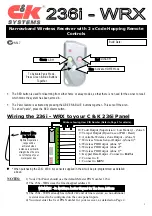
Operation
Surround modes are selected using either
the front panel controls or the remote. To
select a surround mode from the front
panel, simply press the button that corre-
sponds to the desired mode
( Ó Ô
. To select a surround mode using the
remote, press the
Surround Mode
Selector
y
, and then press the
⁄
/
¤
buttons
g
to change the mode. As
you press the buttons, the surround
mode name will appear in the
Main
Information Display
S
, and an
individulal mode indicator will also
light up
D
/
F
/
J
.
Note that the Dolby Digital Mode may
only be selected when a Dolby Digital
source is playing. For more information
on Dolby Digital, see the following section
of this manual.
To listen to a program in traditional two-
channel stereo, using the front left and
front right speakers only (plus the sub-
woofer if installed and configured), press
the
Surround Off
button
Ú
on the
front panel, or follow the insturctions
shown above for using the remote until
SURR OFF
appears in the
Main
Information Display
S
. When the
AVR45’s surround circuits are turned off,
and it is in the Stereo mode, the
BYPASS
indicator
B
will illuminate in the
Information Display
˝
.
Digital Audio Playback
Dolby Digital
Dolby Digital (also known as AC-3) is the
latest advancement in surround-sound
technology, delivering up to five full-
range surround channels (left, center,
right, left surround and right surround)
plus a special dedicated Low-Frequency
Effects (LFE) channel. This represents a
major advancement over traditional
analog surround in that each surround
channel is fully discrete and capable of
full bandwidth reproduction. Dolby
Digital is available on DVD and LV discs,
and it will be a part of the new high-
definition television (HDTV) system
when digital broadcasting begins in
1998. Dolby Digital for the home is based
on the same system used to deliver digital
audio sound tracks in movie theaters,
enabling true cinema reproduction in
your home.
To utilize the Dolby Digital mode you
must have a digital source properly
connected to the AVR45. Connect the
Digital datastream outputs from DVD
players, HDTV receivers and CD players to
the
AC-3/PCM Coaxial
or
Optical
inputs on the rear panel
° ·
. In order
to provide a backup signal and a source
for recording, the analog outputs provid-
ed on digital source equipment should
also be connected to their appropriate
inputs on the AVR45 rear panel (e.g.,
connect the analog stereo audio output
from a DVD to the
DVD
inputs
¶
on
the rear panel when you connect the
digital outputs.)
When playing back a digital source, first
select the input using the remote or front
panel controls as outlined above. Next
select the digital source by pressing the
appropriate
Digital Input
button
w
ˆ
and then using the
⁄
/
¤
buttons
g
on the remote or the
Selector
buttons
¸
on the front panel to choose either
COAXIAL
or
DIGITAL
, as it
appears in the
Main Information
Display
S
. Press the
Set
button
i
˜
to enter the desired choice. When
the digital source is playing, the AVR45
will automatically detect if it is a multi-
channel Dolby Digital source or a con-
ventional PCM signal, which is the
standard output from CD players. An
indicator will light in the Information
Display to confirm the digital signal is
AC-3
H
or
PCM
I
and if the source is
OPTICAL
E
or
COAX
G
.
When an AC-3 source is playing, the
AVR45 will automatically switch to the
Dolby Digital surround mode. It is impor-
tant to note, however, that not all AC-3
sources are encoded with the full comple-
ment of five channels plus LFE. When a
digital source is playing, the
Main
Information Display
S
will change to
show the input source and digital type
(
OPTICAL
or
COAX
). When a source with
Dolby Digital encoding is playing, the
input source name will appear in the
Information Display, followed by a
numeric key to the type and number
of channels being decoded as follows:
24
AVR45 120 volt Rev (f) 7/1/98
AVR45 om (Eng,Fr) 9/15/98 1:19 PM Page 24
Summary of Contents for AVR45
Page 3: ...Staple or clip original invoice here ...
Page 46: ...Notes 43 ...
Page 47: ...Notes 44 ...
Page 49: ...Attacher la facture originale ici avec agrafe ou trombone ...
Page 92: ...Remarques 43 ...
Page 93: ...Remarques 44 ...
















































